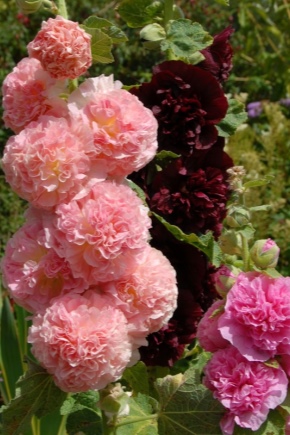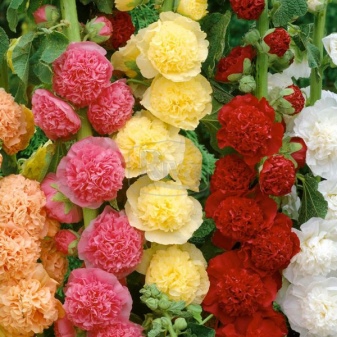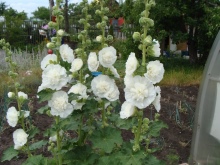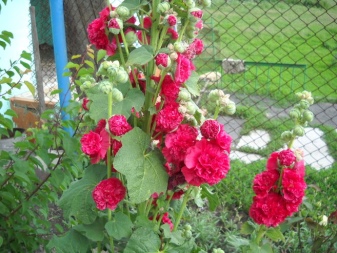Terry mallow: description, recommendations for cultivation and reproduction

Terry mallow is a beautiful perennial plant, decorated with lush, catchy, original flowers. Gardeners love the stock-rose, as the mallow is also called, for its unpretentiousness, a long flowering period. Planting, caring for and growing terry mallow will not be difficult even for the most inexperienced gardener.


Description and features
Mallow is a hybrid plant, it was bred by crossing a wrinkled and a stock-rose. This flower is terry, beautiful, looks like a peony. However, by the duration of flowering, it stands out among all the named varieties and species. Mallow blooms in June and continues to bloom until early autumn. The color of this plant is very expressive and varies from snow-white to pale peach and dark purple tones.



There are a lot of varieties of this luxurious flower today. Main external characteristics:
- the plant reaches a height of 2 m, the minimum growth of the stem with a peduncle is 75 cm;
- inflorescences of a large type, a cross between a carnation and a peony;
- carved petals along the edge, with a wave;
- juicy, saturated shades attract attention;
- in the cut they stand for a long time;
- flowering begins from the lower inflorescences and gradually goes up.



Terry mallow can be perennial or biennial, but is often grown from seed, like an annual plant. It is recommended to grow seedlings in order to contemplate flowering already this year. If planted with seeds, then the first flowers will appear only after a year.
This thermophilic flower is not hardy enough; it grows like an annual in harsh conditions - this should be taken into account.


How to choose a site?
Since the plant loves warmth, you should choose an area with good lighting and high-quality heating. Open terrain is optimal, but it is worth considering that the mallow does not like drafts. If you plant this representative of the flora in the shade, then the stems will be strong and tall, and the abundance of flowers is more modest. There are varieties that do not bloom at all in the shade.
It is very important to choose the right soil - with drainage, fertile type. If the soil is poor, then it should be fed regularly so that development is complete. The ideal soil option is loam. Another significant point is the preparation of the site:
- it is enriched with sand, peat, humus;
- then the future flower bed should be dug up with a minimum depth of 20 cm;
- the mallow is planted with an interval of at least half a meter between each flower;
- it should be remembered that this plant grows extremely actively.


Reproduction
There are several methods for breeding terry mallow. They are all simple and quite effective, but it is worth studying the characteristics of each before choosing the most suitable one.
Seed method
The seeds of this plant sprout well, but in order to achieve really high productivity, it is better to plant seeds that have been stored for 2 years. About 21 days after sowing, shoots appear, sometimes a little earlier. You can sow mallow in open ground at different times:
- in the fall - if you live in the southern regions, then the flowering will be before the onset of winter;
- in winter, mallow is planted in the last week of September;
- flowers are also sown in April, but the first flowers will appear only after a year.
The seeds are laid out in holes at a distance of at least half a meter from each other, the minimum depth is 2 cm.At the end of planting, the area should be mulched with leaves or peat.
It is very important to weed the beds immediately after germination, otherwise the weeds will interfere with the healthy development of the mallow.


Seedling method
In February or March, you can plant seeds at home. This is done in peat pots, where a couple of seeds are placed. Weak seedlings should be removed afterwards. Before planting, the seeds are soaked in a stimulant solution and kept under polyethylene at a temperature of + 20 C.
You can also plant seeds in large containers, 5 cm apart. As soon as shoots appear, the shelter is removed. Seedlings are planted with clods of earth, having previously hardened the plant for 2 weeks.

Cuttings
This method is suitable for experienced gardeners, since not all plants will take root, this must be taken into account. However, this method allows you to preserve species characteristics by 100%. Seed and transplant methods do not guarantee this. Cuttings are carried out in the spring - by dividing the rhizomes or in June - by cutting off the shoots. For rooting, cuttings are placed in peat or nutrient-type soil. In the fall, they are planted in open ground.

Care activities
One of the important advantages of terry mallow is that it is not capricious in its care. The activities are simple, but require regularity.
Watering:
- watering should not be too frequent, 1-2 times a week is enough;
- if the weather is dry, you can increase the number of irrigations up to 3;
- the most abundant hydration is carried out at the flowering stage;
- in no case should moisture stagnation be allowed, it is fatal to mallow.

Fertilizer:
- feeding is carried out in small portions, but regularly;
- fertilize flowers with organic compounds, also compounds with potassium and phosphorus;
- organic matter is introduced every six months;
- during the season, fertilizing with minerals is carried out twice a month;
- if you mulch the plant with compost, 2 goals will be achieved at once.

For the normal development of terry mallow, it is necessary to free it from weeds, loosen the soil. These procedures increase oxygen access to the root system.
However, you should be careful, as the roots in the upper layer of the soil are quite easy to damage, and this leads to serious diseases and even death of mallow.

Diseases and pests
Mallow often get sick, in addition, there are various pests that attack the plant. The most dangerous diseases are:
- powdery mildew;
- sheet type mosaic;
- rust.


A sign of any of the described ailments is a reason to immediately destroy all infected areas, optimally burn them. After that, spraying with compositions containing copper is carried out.
As for pests, if the summer is wet, you can encounter slugs. These insects are collected, for prevention, sprinkle the soil under the mallow with shells of eggs or hot pepper. If summer, on the contrary, is dry, the plant can attack spider mites, aphids. Spraying with insecticides is saved from them.


Application in landscape design
In the past, this plant was most often used as a backdrop for other crops and was located along the hedges. The modern landscape allows for more spectacular variations with the placement of mallow in the center of the compositions, as a decoration for the paths. The large terry buds are incredibly attractive and can be admired anywhere in the garden.
An effective way to decorate is to plant mallow along the wall of the house or along the path that leads to it. You can plant the plant in combination with other representatives of the flora or as a single planting.



The terry variety is ideal for home decor on the south side, other flowers that love the sun can be planted nearby. Mallow - does not fade, does not lose its decorative effect under direct rays. To make your garden really beautiful and well-groomed, designers recommend considering the following points:
- a mallow of a pale pink tone looks luxurious in a duet with lavender;
- flower terry perfectly emphasizes sculptures, figurines, statues located anywhere on the site;
- high varieties of mallow look great when planted along walls, recreation areas.


See the following video for the secrets of growing mallow.







































































































An interesting and informative page, like a magazine.
The comment was sent successfully.